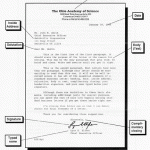 Welcome to our topic on the Parts of a Business Letter! As a technical writer, you should have complete mastery over these parts. Your knowledge on how these parts of a business letter works would be put into good use here. So, what are you waiting for, hop in and prepare your pen and papers for we will write multiple business letters. Enjoy writing!
Welcome to our topic on the Parts of a Business Letter! As a technical writer, you should have complete mastery over these parts. Your knowledge on how these parts of a business letter works would be put into good use here. So, what are you waiting for, hop in and prepare your pen and papers for we will write multiple business letters. Enjoy writing!
Intended learning outcomes (ILOs)
At the end of this topic, you should be able to:
- Explain the parts of a business letter;
- Follow the guidelines in writing a business letter.
Parts of a Business Letter
A business letter is more formal than a personal letter. It should have a margin of at least one inch on all four edges. It is always written on 8½”x11″ (or metric equivalent) unlined stationery. The Parts of a Business Letter may be grouped into major parts and minor (supplementary) parts. Knowledge of business letter etiquette is essential for anyone in or entering the workplace. Professional types of correspondence such as letters of application, sales letters and letters of reference differ from friendly letters in that they must follow a specific format and should never include informal or slang language.
The Seven Major (Essential) Parts of a Business letter include:
- Letterhead or Heading. Most professional business correspondence is printed on a letterhead template. A letterhead contains the company name, address and contact information. An individual may also create a letterhead that contains his name and personal contact information. While some individuals may choose not to create a formal letterhead, it is always necessary to include a header with the sender’s information.
- Date. Simply put, the date is the day the letter is sent. The most commonly used date format is: August 6, 2018. Do not abbreviate the month and always include all four digits of the year.
- Inside Address. This is the address of the recipient. If applicable, the first line in the address block should include the recipient’s name and title, and the second line should state the recipient’s company or business. The third and fourth lines are designated for the actual address.
- Greetings or Salutation. Different circumstances determine which salutation or greeting is most appropriate. Use “Dear” when the recipient’s name or title is known. Examples include “Dear Mr. Doe” or “Dear Sales Director.” When the name or title is unknown, use “To Whom It May Concern.” Always punctuate the salutation of a business letter with a colon (:) instead of a comma.
- Body. The body is the longest part of a letter and is usually divided into three subcategories: introduction, main content and summary. The introductory paragraph states the purpose of the letter. The main content conveys all necessary detailed information and has no set length requirements. The last paragraph summarizes the information provided, restates the letter intent and offers either instructions or an inquiry regarding follow-up correspondence.
- Complimentary Close. The complimentary close is a word or short phrase that basically means “goodbye.” “Sincerely” is the most common closing remark. Others include “cordially,” “best wishes,” and “best regards.” The complimentary close can vary in degrees of formality and is dependent upon the relationship between the sender and recipient.
- Signature. In letters that are sent via email, the signature is simply the sender’s name and title typed immediately below the complimentary close. When a letter is mailed, faxed or hand-delivered, however, there should be a large enough space below the closing and above the typed name and title for the sender to provide her written signature.
The Minor (Supplemental) Parts of a Business Letter are as follows:
- Attention Line. This part directs letter to a specific person or position who will read and pay attention to the letter. It is often written using the format: Attention: <Name> <Position>
- Subject Line. This part identifies main topic/business/purpose why the letter was written. It is often written using the format: Subject: <Adjustment Letter> or with the use of Re: <Letter of Inquiry>
- Identification initials. This part contains the initials of whoever typed the business letter.For example, the initials, /SSA identifies that Salirick S. Andres typed the letter.
- Enclosure or attachment notation. This part contains any attached documents or any additional material in the mail or envelope. For example, the enclosure notation, Encl (5) identifies that there are five enclosed or attached documents in the letter.
- Copy notation. This part identifies other persons or parties receiving the letter whether as a Carbon Copy (CC) where all recipients know who else received the letter or a Blind Carbon Copy (BCC) where each recipient is unaware who else received the letter.
- Postscript. This part, normally written as Post Script or PS adds personal comment or emphasis or any additional message the writer wants to include but not able to include it in the body of the letter.
References
- English Plus. (2006). Business Letters. EnglishPlus.com, Accessed on August 5, 2018, on the website: http://englishplus.com/grammar/00000149.htm
- Alison Datko. (2018). The Seven Parts of a Letter. Classroom.com. Accessed on August 5, 2018, on the website: https://classroom.synonym.com/the-seven-parts-of-a-letter-12084087.html